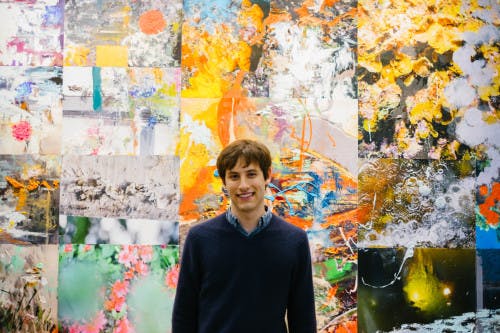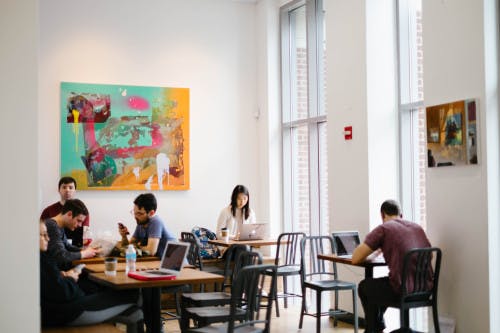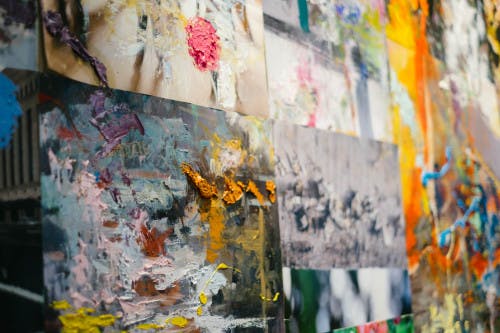We Met Over Coffee

One of our most favorite things about our UPenn café is that it doubles as an art gallery (thanks to a pretty amazing partnership with UPenn’s Fine Arts Department). Each semester, we work with a student curator — and this time around, we had the pleasure of collaborating with painter, photographer, and part-time scientist Sam Sherman. This fine arts & chemistry double major layers paint marks and digital photographs to generate color worlds and varied textural surfaces that represent his experience in the image-saturated Internet age. The result: Technicolor pieces that add a refreshing pop of color to our 40th & Locust café. We chatted with Sam about his favorite materials to work with, the inspiration behind this exhibit, and which Philly galleries are worth a weekly visit.

Tell us about you! How did you first determine you wanted to be a fine arts (and chemistry!) major?
I have always loved to draw, even from a very early age. When I turned seven, I began taking lessons in oil painting at Acorn Art School, a local afterschool program in Marblehead, MA, and continued until I graduated high school. I was trained in traditional still-life and figure painting and drawing. During high school, I also developed an interest in chemistry. When I was applying to college, I looked for schools that had programs in both fine arts and chemistry and a curriculum that was open enough to make it feasible to study both. This led me to Penn, and now, four years later, I will be graduating this May with a double major in fine arts and chemistry.
What are your favorite materials to work with?
I mainly work with oil paint and photographs, but I identify as a painter as opposed to a photographer. I often incorporate photography into my paintings as a way of combining multiple visual languages to create hybrid spaces. More recently, I have been interested in photo transfers, which are made in the nearly the same way as temporary tattoos, because they allow me to incorporate distressed images into my work. I can also create transparencies with photo transfers that enable me to densely layer imagery in my paintings without adding actual texture. When paint is applied over these photo transfers, the texture of the paint interacts with the flatness of the photo transfers to simultaneously generate connection and dislocation.

How would you describe your aesthetic?
I am most interested in the interaction of multiple visual languages in one coherent space, particularly painting, photography, and the digital. I try to discover new relationships among these three overlapping spheres. The aesthetic that I most strongly identify with is that of the hybrid space, which, while composed of imagery from multiple sources, retains more self-contained logic and fluidity than collage per se. My interest in fusing disparate visuals is in part a reaction to globalization and the profusion and bombardment of images in the Internet age.
How did you decide what pieces to include in your Saxbys exhibit?
I wanted to showcase the work I have been making over the past two years, so all of the work I chose for the show was made in the fall of 2014 or later. I chose paintings that best reflect my interests in hybridity and pieces that show variety but still feel cohesive. I also wanted to include works of a variety of scales from quite small to wall size, as well as works on paper and canvas. Due to the size of the space available, I was able to include a fairly large selection of my work, so the more difficult part was determining the layout of the show.

We’re completely obsessed with Connecting Fragments, the large mosaic of photos and paint that you created for the front room! What was the inspiration for that piece?
In traditional art programs, the use of photography as source material for painting is often reviled in favor of work that is made from life. However, the most exciting painting being done today is located at the interstice between photography and painting. For the past couple of years, I have been very interested in thinking about how photography and painting, two very different methods of image production, relate. Connecting Fragments came out of this interest. It was the first painting I made on photographs, which opened up new territory for me as an artist. The idea behind the work was to react with paint to the texture and color worlds of the photographs, and stitch together a new world that, although impossible, retains a logic of its own.
As a Penn senior, you’ve spent at least four years getting to know the city. What are some of your favorite things about Philly? What sets it apart from other cities, in your eyes?
Philly is a culturally vibrant city that has played an important role in my art making. From the Fabric Workshop and the Print Center to the art collectives and Old City galleries, Philadelphia has a unique art scene. Of course, there is also an amazing amount of history in the city, and Old City is one of my favorite places to explore.

What are your favorite places to go in Philly? (Besides Saxbys, of course…)
One of my favorite things to do is take the Schuylkill River Trail to the Philadelphia Museum of Art for an afternoon visit. South Street is also fun to explore. During the summer, Spruce Street Harbor Park is one of my favorite places to hang out.
We have to ask! What’s your go-to order at Saxbys?
For the start of the day, I like black tea, but if I’m looking for something sweeter the Chai Tea Latte is my favorite.
Stop by Saxbys UPenn to see Sam Sherman’s work, which will be on display all spring.

